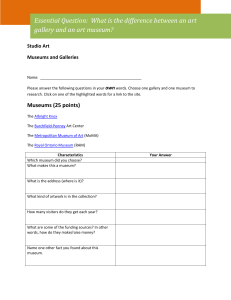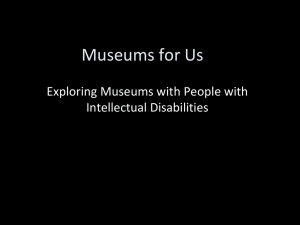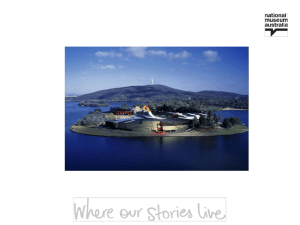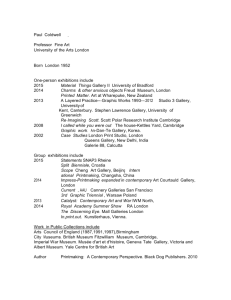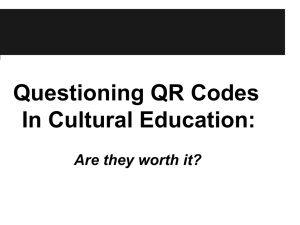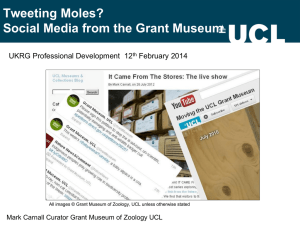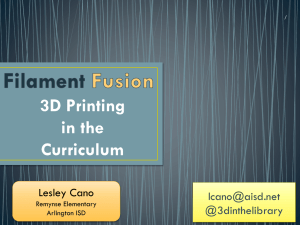Schools
advertisement
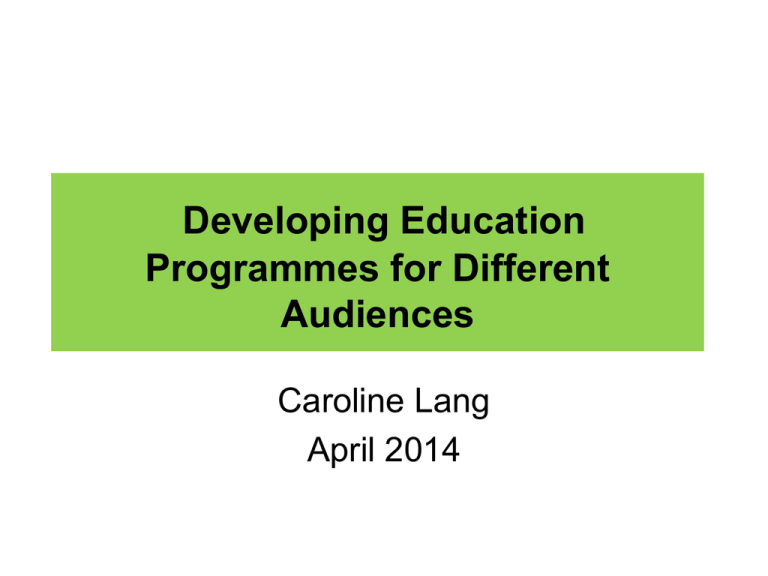
Developing Education Programmes for Different Audiences Caroline Lang April 2014 What are museums and who are they for ? A cultural treasure house A leisure and tourism attraction A source of local pride A memory store for the community A meeting place for promoting dialogue A resource for both informal and structured learning All of these and more Adapted from Black, G. 2012. What is learning in museums and galleries ? A core function of museums Offers opportunities for everyone to develop: a critical understanding of the collections the skills to interpret them visual literacy an understanding of their social, aesthetic and historical context broader and deeper knowledge increased enjoyment A definition of learning ‘Learning is a process of active engagement with experience . It is what people do when they want to make sense of the world . It may involve an increase in skills, knowledge or understanding, a deepening of values or the capacity to reflect. Effective learning will lead to change, development and a desire to learn more .’ The Campaign for Learning in museums and galleries Audiences and Learning Styles Different types of Learning Formal Learning Informal Learning Self-Directed Learning Using Kolb’s learning styles What this means for museums Each visitor learns in a different way They bring their own prior knowledge and experience They personalise the museum’s message They select a small number of experiences from the many on offer Visitors are influenced by the physical aspects of a visit Social context & other encounters eg. with staff are important There is no such thing as an average visitor Exhibitions and education programmes should be designed to appeal to a wide range of visitors. Barriers to access Access is usually seen in terms of barriers which may be: Physical and sensory Intellectual Cultural Attitudinal Financial Barriers which might hinder visitors need to be addressed, ensuring that their specific needs are met. A tale of two museums Victoria and Albert Museum (V&A) : London Opened 1837; National Museum of Art & Design; Around 600 staff ; 2.6 m visitors per year; Budget in yuan per year: 500 m. Hong Kong Maritime Museum Opened 2013: Independent Museum; 30 staff; 80,000 visitors in first year; Budget in yuan per year:15m . V&A’s priority audiences 6 main audience groups Families * Schools* Students* Professionals in the creative industries Groups (other than schools and students) Individual adults not in other categories* Engaging with audiences through programmes Take into account Information from visitor surveys Consultation with users and non users Barriers some visitors perceive Different learning styles: provide variety Audience needs: families Families want: To spend leisure time together in a worthwhile pursuit. Activities to keep children occupied. Direct experience and play for children. Text (panels /labels) that adults are able to scan quickly and answer questions. Questions and suggestions for discussion topics and activities. Level access for baby buggies/ strollers. Baby-changing and family friendly toilets. Affordable family-friendly menu in the café. Note : the children, especially the youngest child, generally drive the visit. Programme: families Regular Saturday programme: Activity back packs and Imagination Station ( Art cart). Regular Sunday programme: Drop-in Design activities, e.g. design and make an accessory in Baroque style School holiday programmes: Drop-in Design Specials, Free Art Fun Festivals, e.g. ‘Arabian Nights’ festival, part of the Arab World Family Learning Programme Audience needs: schools Cloakroom facilities and somewhere to eat. Welcoming attitude from security and other front of house staff. Advance information about what is in the museum and why they should visit. Links to the Curriculum and examination syllabuses. Things that will give structure to their visit, eg gallery tour. Teaching resources usually online. Space in galleries and teaching rooms for groups of 30-35. Programme: schools Workshops, led by artists and designers Gallery talks and exhibition talks on a set menu of themes Big events e.g. ‘Creative Quarter’ which showcases careers in the creative industries Special projects e.g. ‘Design Lab’ in which students work to a brief with professional designers Resources for self-guided visits Courses for teachers, e.g. ‘Drawing Skylines’ where teachers investigate influential drawings and architectural fragments of buildings and places Teacher’s previews for Special Exhibitions Audience needs: university students Need help learning how to ‘read’ museum objects. Need structure and direction when visiting the museum. Outlook and purpose for visiting museums matures over the course of their study. Want resources related to their personal projects. Like different perspectives on the same object. Want to challenge the ‘authority’ of the museum. . . . . . but young undergraduates want to hear from the curators and value their expertise. Post-graduates more interested in views of other students Programme: university students Hard to programme for as courses vary a lot at different universities. Personalised support & resources. Networking with creative industries practitioners is important, events with a social element work well eg Friday Late. Courses for tutors. Induction sessions, e.g on the architecture collections. ‘Behind the scenes’ access to the stores Audience needs: adult learners Manage their own learning rather than being driven by a formal curriculum. Motivated by curiosity and internal incentives Not restricted by conventional subject boundaries. They bring varied experiences to the learning process and often operate through word-ofmouth and networks. Outside their own area of expertise they will be novice learners. They respond to information at different levels and in different ways to tie in with their varied learning styles. Older adults may be short-sighted or have mobility problems. Programme: adult learners Long and short courses on art and design history Academic conferences and symposia Study days and seminars Practical one or two-day workshops or longer practical & digital design courses (daytime or evening) Illustrated lectures and gallery talks Ticketed evening talks by big name speakers Themed special evening or weekend events Concerts and film screenings Setting up education programmes in a new museum Pacifying the South China Sea scroll 靖海全圖 The Education Team • Staff and volunteers. Aim: to offer opportunities for the whole community to enjoy and to learn from our collections Priority Audiences 2013-14 Adults with a general interest Schools Families with younger children Adult talks and tours Schools Teachers’ Guide and help with planning a visit Resources. Activity Sheets linked to the curriculum 4 Topics for Primary schools 5 Topics for Secondary schools Museum – led gallery sessions Workshops Special programmes for temporary exhibitions Outreach: visits to schools Resources Families with young children Started in July 2013. Family corner: 1 Sunday per month •Workshops, art and craft •Family tours with drama Developments for 2014-15 Increase number of local school groups visiting : Hold talks and events for Adults every Saturday Run Family Programme every Sunday Increase number of trained volunteers Develop sessions for older people and teenagers Thank you 謝謝! Caroline.lang@hongkongmaritimemuseum.org Develop a gallery activity to suit …. Families Schools Students (tertiary) Adults (non academic) Young People (teenagers, not with family or school) Elderly people Community Group
